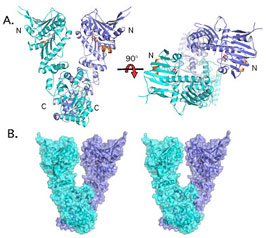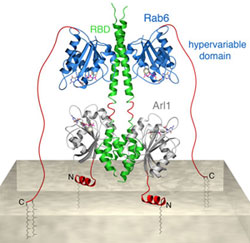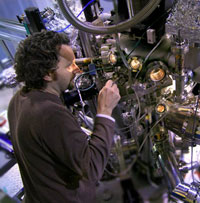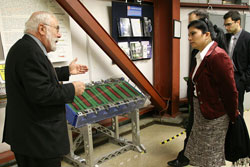

Contents of this Issue:
1. Science Highlight —
A New Window on a Well-Known Family of Proteins
(contacts: D.E. Dollins, J.J. Warren, R.M. Immormino and D.T. Gewirth, HWI)
 | |
| Overview of the GRP94 structure. |
Crystal screening and data collection were carried out using SSRL's user
remote-access system, enabling the research group to perform (and control) the
experiment from their home laboratory.
To learn more about this research see the full scientific highlight at:
http://www-ssrl.slac.stanford.edu/research/highlights_archive/grp94-nucleotide.html
2. Science Highlight —
GTPase Family Proteins Show Microscopic Teamwork
(contacts: A. Schweizer Burguete, T.D. Fenn, A.T. Brunger and S.R. Pfeffer,
Stanford University)
 | |
| Model for dual GTPase binding to adjacent RBD and GRIP domains in GCC185. |
Using x-ray diffraction data collected at SSRL, researchers Alondra Schweizer Burguete and Timothy Fenn determined the structure of a region of the tether in complex with the Rab6 GTPase. They created a model of the system to visualize how the GTPases might cooperate to anchor the tether and thereby capture incoming vesicles. In this model, proteins belonging to the Rab and Arf GTPase families reside at the membrane-anchor point of the tether. A pair of Arl1 GTPase molecules form a previously characterized complex with the tether close to the membrane. At a significant distance (10 nanometers) away from the membrane, a pair of Rab6 molecules bind a distinct tether-region; the Rab GTPases are able to reach this far thanks to their extended and unstructured tail-domains.
The model explains how Arl1 and Rab6 GTPases may cooperate in anchoring the tether to the Golgi membrane, thereby directing incoming vesicles to the Golgi membrane prior to fusion. This represents a first-ever instance of such a cooperative relationship among different members of these GTPase families.
The results are published in the January 25 edition of the journal Cell.
To learn more about this research see the full scientific highlight at:
http://www-ssrl.slac.stanford.edu/research/highlights_archive/rab-arl_gtpases.html
see also: SLAC TODAY article at: http://today.slac.stanford.edu/feature/2008/cell.asp
3.
Budget May Impact User Operations
(contact: C. Knotts, knotts@slac.stanford.edu)
As you may already know, the FY08 budget for science was much less than
expected. This will likely result in reduced operational hours at many DOE
funded facilities, including SSRL. We are currently assessing the situation and
discussing the potential impact on user operations with the SSRL Users'
Organization Executive Committee.
4.
Unique SSRL-Stanford Collaboration Illuminates Rare Materials
—SLAC
Today article by Heather Rock Woods
 |
| Rob Moore at Beam Line 5-4 |
With three different techniques brought to bear on these rare-earth tri-telluride compounds, "We get a much more complete picture," said SSRL physicist Mike Toney. "All of the studies are complementary, related to understanding the same phenomenon."
The phenomenon is the formation of a "charge density wave," a kind of electronic instability where the electrons aren't where you'd expect them to be inside the material. The movement of electrons to those new locations also distorts the positions of atoms within the material, changing aspects of the material's behavior.
At the Geballe Lab, Nancy Ru and Ian Fisher used their table-top lab equipment to run current through the materials to measure the resistance to electron flow at different temperatures. These data provided the first evidence for the occurrence of electronic instabilities in these materials, and indicated the most interesting temperature regions for the two groups at SSRL to investigate. At BL5-4, Rob Moore and Z.-X. Shen of SLAC's X-ray Laboratory for Advanced Materials (XLAM) shone intense UV-light on the material to eject electrons and then analyze their energy and momentum using a technique called Angle-Resolved Photoemission Spectroscopy (ARPES). This technique reveals the material's electronic structure-where the electrons are-and how it changes due to the existence of the charge density wave. On BL7-2, Ru, coworker Kyungyun Shin, SSRL postdoctoral researcher Cathie Condron, Fisher and Toney sent x-rays through the material to get diffraction patterns at different temperatures. These patterns showed changes in the atomic structure that were directly correlated with changes in the electronic structure observed in the ARPES data. The combined results enable a deeper understanding of the driving forces behind the changes in atomic and electronic structure in this and related materials.
"Understanding a simpler system like this might help us understand why materials behave this way," said Moore. "The ultimate goal is to understand the fundamental physics so we could design materials with properties we desire, such as superconductors that operate at room temperature."
5.
SSRL Users' Organization Update
(contact: R. Szilagyi, szilagyi@montana.edu, SSRLUOEC Chair)
The SSRL Users' Organization Executive Committee (SSRLUOEC) met recently on December 14 and January 31. Several topics were discussed at these meetings, including the draft SSRLUOEC charter (review at http://www-ssrl.slac.stanford.edu/users/ssrluo/ssrluo_charter.html), plans for the 2008 user survey, plans for the 2008 SSRL/LCLS Users' Meeting, and User Outreach/Activism. The SSRLUOEC is also meeting with SSRL management to discuss the impact of the reduced budget on user operations as well as future plans for SSRL. All users are invited to participate in these meetings, and notes from the meetings are posted on the web to keep users informed about committee activities, see http://www-ssrl.slac.stanford.edu/users/ssrluo/minutes_dec07.html.
Even if you are unable to attend the users' organization meetings, we encourage you to share your feedback and suggestions with us by contacting anyone on the committee http://www-ssrl.slac.stanford.edu/users/ssrluo/ssrluoec-fy08.html, or by completing the on-line user survey which we are now conducting at https://www.surveymonkey.com/s.aspx?sm=o5ICDralcEn8kpFsqSgKEA_3d_3d This survey is a follow up to the one conducted last year, and something which we plan to do annually. The user survey serves as a very important communication channel between the SSRL user community and the SSRL Users' Organization Executive Committee. We will use your feedback via this survey to organize the next SSRL/LCLS Users meeting, to prepare reports to SSRL management as well as advisory and review committees, and of course to continue to improve the overall user experience at SSRL both in science and otherwise. The survey has only 10 questions, is designed to be straightforward, and is estimated to only take ~15 minutes to complete. Wherever you see a box for comments, we invite you to elaborate beyond just the specific survey questions. As an added incentive, we will have a random drawing of several prizes including a free night stay at the Guest House, SSRL shirts, SSRL baseball caps, and SSRL coffee mugs for users who complete the survey.
We thank you in advance for your input on the survey and for participating in user advocacy activities such as the email writing campaign to positively affect the future of science in the US (Response by SSRL users was among the highest - way to go SSRL users!). Best wishes for a successful 2008!
6.
Princess Sumaya of Jordan Visits SLAC
—SLAC
Today article by Kelen Tuttle
 |
| Herman Winick showing Princess Sumaya bint El Hassan of Jordan a piece of SSRL history—the first wiggler which was installed on BL4 in 1978. |
After meeting with Persis Drell and other directorate members, Princess Sumaya
toured the laboratory with Keith Hodgson and host Herman Winick, who, along
with Gus Voss of DESY, initiated the SESAME Project in 1997. Uwe Bergmann
explained how x-rays can be used to read overwritten ancient manuscripts, and
Les Cottrell talked about the digital divide with emphasis on the Middle East.
After visiting SLAC she had lunch with President Hennessy and Arthur
Bienenstock. Following this she gave a talk and had spirited exchanges with
Stanford faculty and students at the Center for Democracy, Development and the
Rule of Law on the Stanford campus.
"In her interactions she proved to be charming, as well as articulate about the
problems in Jordan and the Arab world in general while describing her
activities and ideas about addressing them with science and technology," said
Winick. "Many thanks to everyone who helped with her visit."
7.
Upcoming Beam Time Request and Proposal Deadlines
3/14/08 - Beam Time Requests for 3rd Scheduling Period Due
4/01/08 - Macromolecular Crystallography spring proposal deadline
5/01/08 - X-ray/VUV spring proposal deadline
__________________________________________________________________________
SSRL Headlines is published electronically monthly to inform SSRL users, sponsors and other interested people about happenings at SSRL. SSRL is a national synchrotron user facility operated by Stanford University for the U.S. Department of Energy Office of Basic Energy Sciences. Additional support for the structural biology program is provided by the DOE Office of Biological and Environmental Research, the NIH National Center for Research Resources and the NIH Institute for General Medical Sciences. Additional information about SSRL and its operation and schedules is available from the SSRL WWW site.
__________________________________________________________________________
To leave the SSRL-HEADLINES distribution, send email as shown below:
To: LISTSERV@SSRL.SLAC.STANFORD.EDU Subject: (blank, or anything you like)
The message body should read
SIGNOFF SSRL-HEADLINES
That's all it takes. (If we have an old email address for you that is forwarded to your current address, the system may not recognize who should be unsubscribed. In that case please write to ssrl-headlines-request@ssrl.slac.stanford.edu and we'll try to figure out who you are so that you can be unsubscribed.)
If a colleague would like to subscribe to the list, he or she should send To: LISTSERV@SSRL.SLAC.STANFORD.EDU and use the message body
SUBSCRIBE SSRL-HEADLINES
|
SSRL Welcome
Page | Research
Highlights | Beam Lines | Accel
Physics
User Admin | News & Events | Safety Office |